stop start FIAT DOBLO PANORAMA 2018 Owner handbook (in English)
[x] Cancel search | Manufacturer: FIAT, Model Year: 2018, Model line: DOBLO PANORAMA, Model: FIAT DOBLO PANORAMA 2018Pages: 272, PDF Size: 23.75 MB
Page 69 of 272
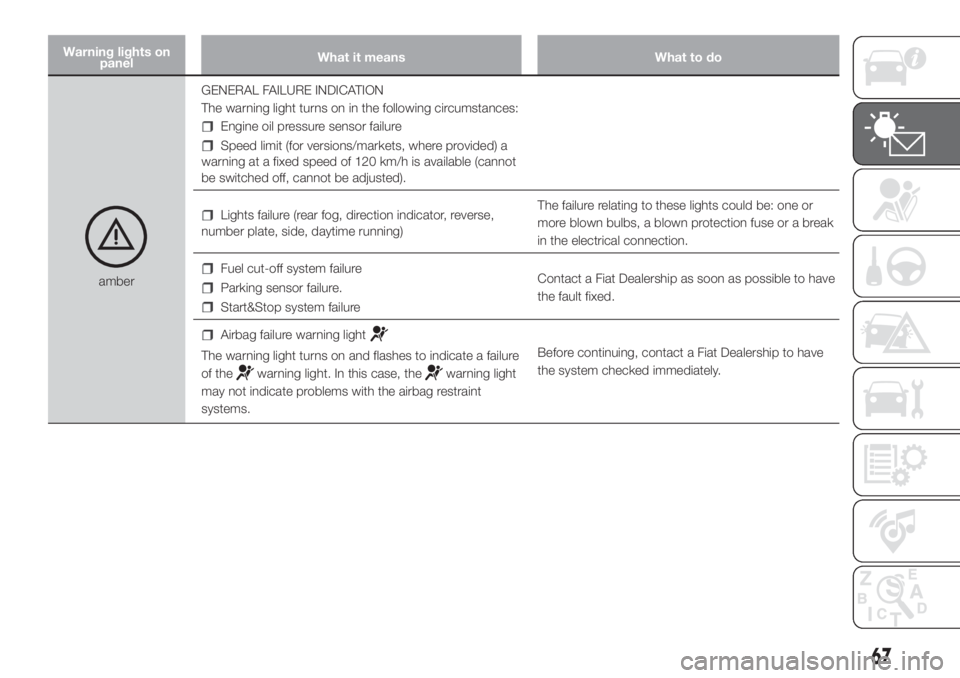
Warning lights on
panelWhat it means What to do
amberGENERAL FAILURE INDICATION
The warning light turns on in the following circumstances:
Engine oil pressure sensor failure
Speed limit (for versions/markets, where provided) a
warning at a fixed speed of 120 km/h is available (cannot
be switched off, cannot be adjusted).
Lights failure (rear fog, direction indicator, reverse,
number plate, side, daytime running)The failure relating to these lights could be: one or
more blown bulbs, a blown protection fuse or a break
in the electrical connection.
Fuel cut-off system failure
Parking sensor failure.
Start&Stop system failureContact a Fiat Dealership as soon as possible to have
the fault fixed.
Airbag failure warning light
The warning light turns on and flashes to indicate a failure
of the
warning light. In this case, thewarning light
may not indicate problems with the airbag restraint
systems.Before continuing, contact a Fiat Dealership to have
the system checked immediately.
67
Page 73 of 272
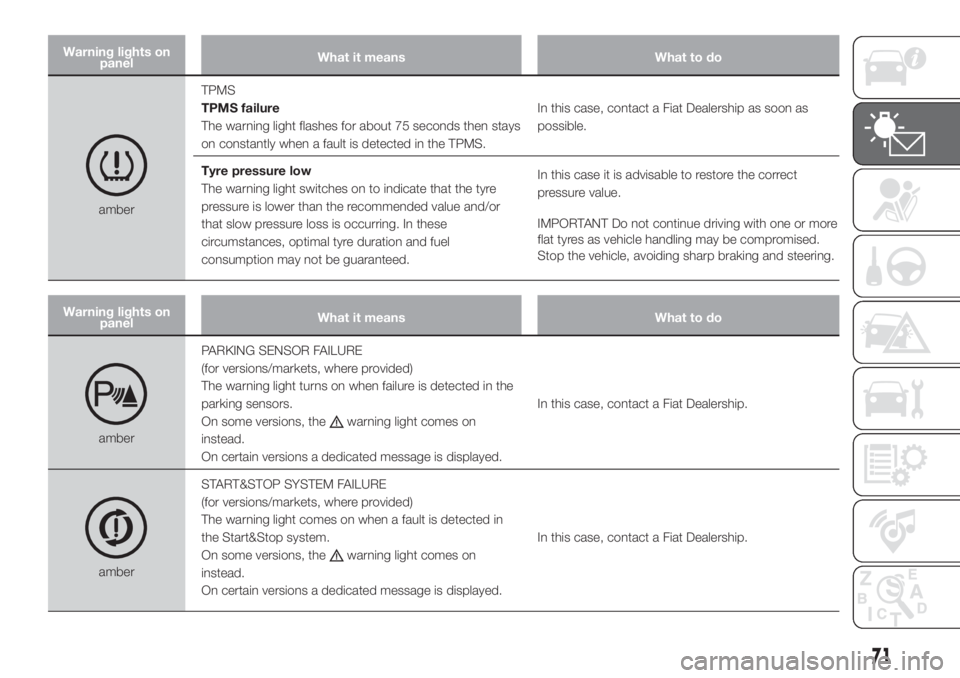
Warning lights on
panelWhat it means What to do
amberTPMS
TPMS failure
The warning light flashes for about 75 seconds then stays
on constantly when a fault is detected in the TPMS.In this case, contact a Fiat Dealership as soon as
possible.
Tyre pressure low
The warning light switches on to indicate that the tyre
pressure is lower than the recommended value and/or
that slow pressure loss is occurring. In these
circumstances, optimal tyre duration and fuel
consumption may not be guaranteed.In this case it is advisable to restore the correct
pressure value.
IMPORTANT Do not continue driving with one or more
flat tyres as vehicle handling may be compromised.
Stop the vehicle, avoiding sharp braking and steering.
Warning lights on
panelWhat it means What to do
amberPARKING SENSOR FAILURE
(for versions/markets, where provided)
The warning light turns on when failure is detected in the
parking sensors.
On some versions, the
warning light comes on
instead.
On certain versions a dedicated message is displayed.In this case, contact a Fiat Dealership.
amberSTART&STOP SYSTEM FAILURE
(for versions/markets, where provided)
The warning light comes on when a fault is detected in
the Start&Stop system.
On some versions, the
warning light comes on
instead.
On certain versions a dedicated message is displayed.In this case, contact a Fiat Dealership.
71
Page 77 of 272
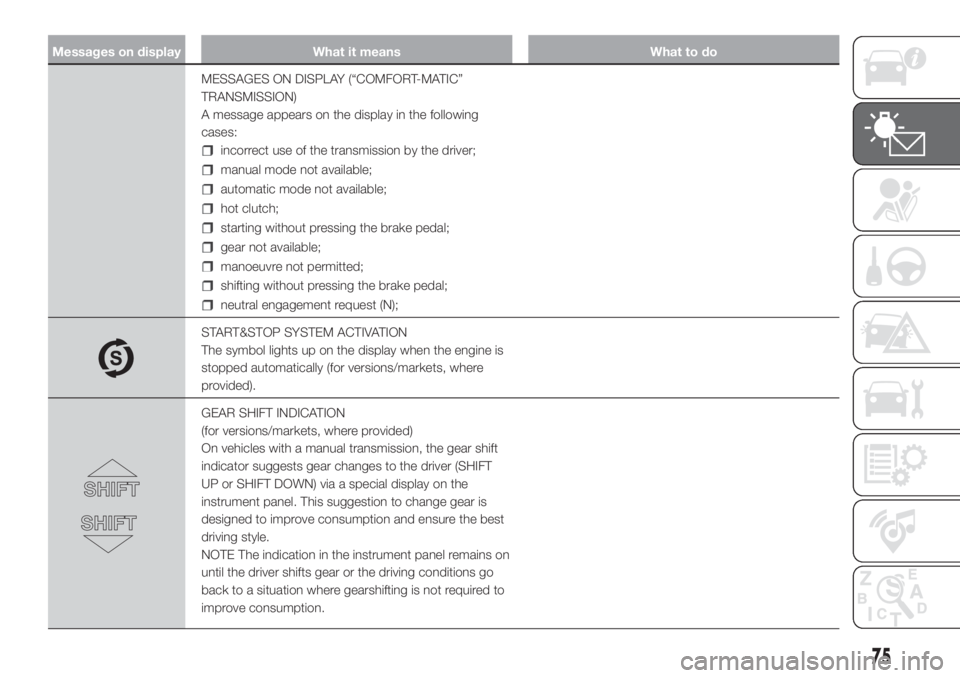
Messages on display What it means What to do
MESSAGES ON DISPLAY (“COMFORT-MATIC”
TRANSMISSION)
A message appears on the display in the following
cases:
incorrect use of the transmission by the driver;
manual mode not available;
automatic mode not available;
hot clutch;
starting without pressing the brake pedal;
gear not available;
manoeuvre not permitted;
shifting without pressing the brake pedal;
neutral engagement request (N);
START&STOP SYSTEM ACTIVATION
The symbol lights up on the display when the engine is
stopped automatically (for versions/markets, where
provided).
GEAR SHIFT INDICATION
(for versions/markets, where provided)
On vehicles with a manual transmission, the gear shift
indicator suggests gear changes to the driver (SHIFT
UP or SHIFT DOWN) via a special display on the
instrument panel. This suggestion to change gear is
designed to improve consumption and ensure the best
driving style.
NOTE The indication in the instrument panel remains on
until the driver shifts gear or the driving conditions go
back to a situation where gearshifting is not required to
improve consumption.
75
Page 85 of 272
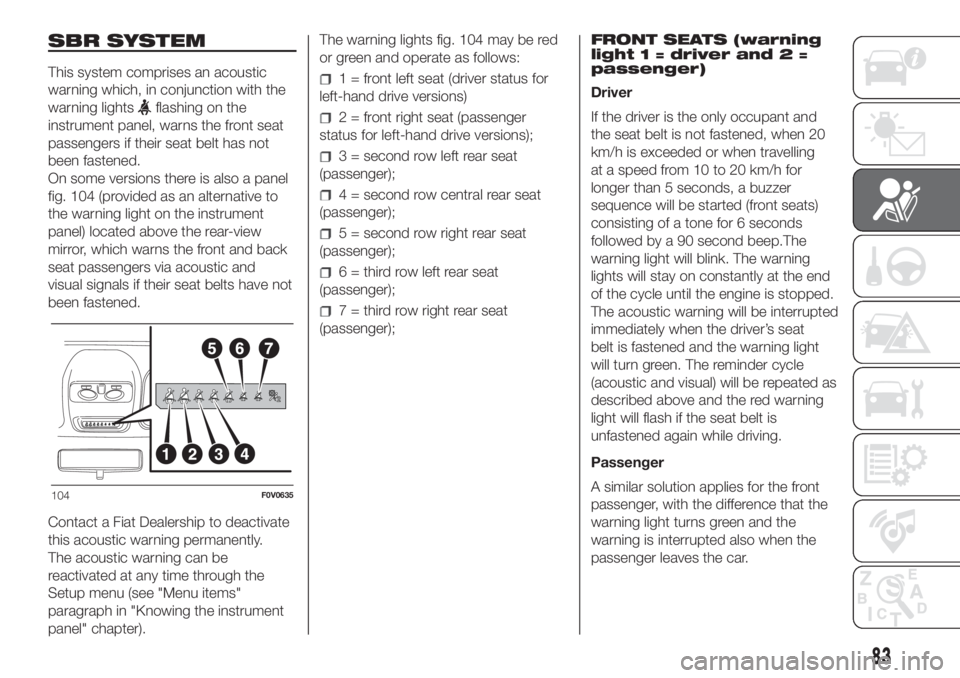
SBR SYSTEM
This system comprises an acoustic
warning which, in conjunction with the
warning lights
flashing on the
instrument panel, warns the front seat
passengers if their seat belt has not
been fastened.
On some versions there is also a panel
fig. 104 (provided as an alternative to
the warning light on the instrument
panel) located above the rear-view
mirror, which warns the front and back
seat passengers via acoustic and
visual signals if their seat belts have not
been fastened.
Contact a Fiat Dealership to deactivate
this acoustic warning permanently.
The acoustic warning can be
reactivated at any time through the
Setup menu (see "Menu items"
paragraph in "Knowing the instrument
panel" chapter).The warning lights fig. 104 may be red
or green and operate as follows:
1 = front left seat (driver status for
left-hand drive versions)
2 = front right seat (passenger
status for left-hand drive versions);
3 = second row left rear seat
(passenger);
4 = second row central rear seat
(passenger);
5 = second row right rear seat
(passenger);
6 = third row left rear seat
(passenger);
7 = third row right rear seat
(passenger);FRONT SEATS (warning
light 1 = driver and 2 =
passenger)
Driver
If the driver is the only occupant and
the seat belt is not fastened, when 20
km/h is exceeded or when travelling
at a speed from 10 to 20 km/h for
longer than 5 seconds, a buzzer
sequence will be started (front seats)
consisting of a tone for 6 seconds
followed by a 90 second beep.The
warning light will blink. The warning
lights will stay on constantly at the end
of the cycle until the engine is stopped.
The acoustic warning will be interrupted
immediately when the driver’s seat
belt is fastened and the warning light
will turn green. The reminder cycle
(acoustic and visual) will be repeated as
described above and the red warning
light will flash if the seat belt is
unfastened again while driving.
Passenger
A similar solution applies for the front
passenger, with the difference that the
warning light turns green and the
warning is interrupted also when the
passenger leaves the car.
104F0V0635
83
Page 105 of 272
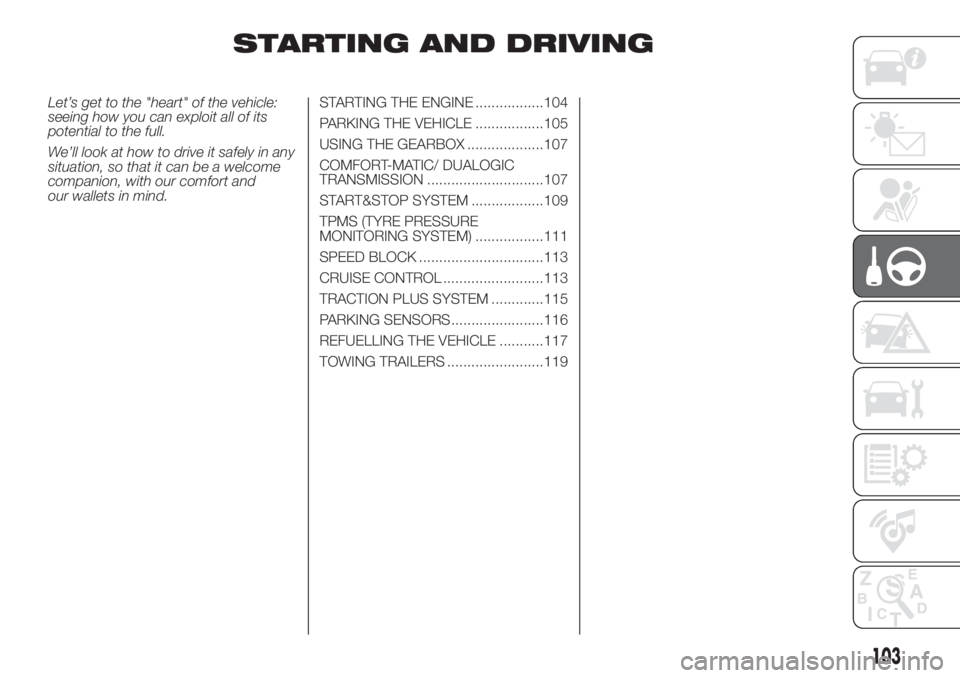
STARTING AND DRIVING
Let’s get to the "heart" of the vehicle:
seeing how you can exploit all of its
potential to the full.
We’ll look at how to drive it safely in any
situation, so that it can be a welcome
companion, with our comfort and
our wallets in mind.STARTING THE ENGINE .................104
PARKING THE VEHICLE .................105
USING THE GEARBOX ...................107
COMFORT-MATIC/ DUALOGIC
TRANSMISSION .............................107
START&STOP SYSTEM ..................109
TPMS (TYRE PRESSURE
MONITORING SYSTEM) .................111
SPEED BLOCK ...............................113
CRUISE CONTROL .........................113
TRACTION PLUS SYSTEM .............115
PARKING SENSORS.......................116
REFUELLING THE VEHICLE ...........117
TOWING TRAILERS ........................119
103
Page 106 of 272
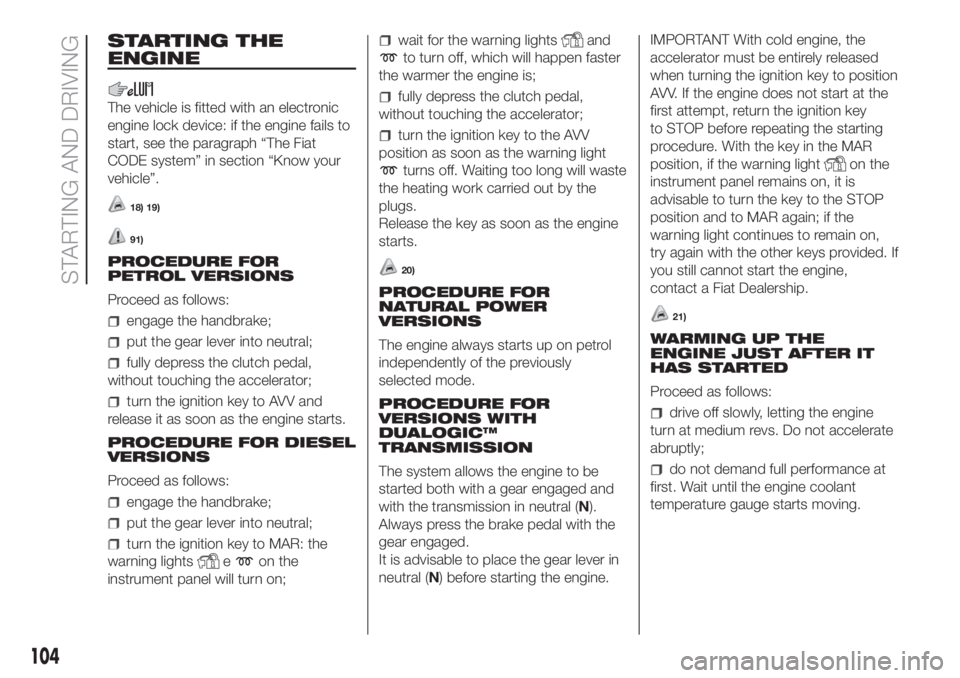
STARTING THE
ENGINE
The vehicle is fitted with an electronic
engine lock device: if the engine fails to
start, see the paragraph “The Fiat
CODE system” in section “Know your
vehicle”.
18) 19)
91)
PROCEDURE FOR
PETROL VERSIONS
Proceed as follows:
engage the handbrake;
put the gear lever into neutral;
fully depress the clutch pedal,
without touching the accelerator;
turn the ignition key to AVV and
release it as soon as the engine starts.
PROCEDURE FOR DIESEL
VERSIONS
Proceed as follows:
engage the handbrake;
put the gear lever into neutral;
turn the ignition key to MAR: the
warning lights
eon the
instrument panel will turn on;
wait for the warning lightsand
to turn off, which will happen faster
the warmer the engine is;
fully depress the clutch pedal,
without touching the accelerator;
turn the ignition key to the AVV
position as soon as the warning light
turns off. Waiting too long will waste
the heating work carried out by the
plugs.
Release the key as soon as the engine
starts.
20)
PROCEDURE FOR
NATURAL POWER
VERSIONS
The engine always starts up on petrol
independently of the previously
selected mode.
PROCEDURE FOR
VERSIONS WITH
DUALOGIC™
TRANSMISSION
The system allows the engine to be
started both with a gear engaged and
with the transmission in neutral (N).
Always press the brake pedal with the
gear engaged.
It is advisable to place the gear lever in
neutral (N) before starting the engine.IMPORTANT With cold engine, the
accelerator must be entirely released
when turning the ignition key to position
AVV. If the engine does not start at the
first attempt, return the ignition key
to STOP before repeating the starting
procedure. With the key in the MAR
position, if the warning light
on the
instrument panel remains on, it is
advisable to turn the key to the STOP
position and to MAR again; if the
warning light continues to remain on,
try again with the other keys provided. If
you still cannot start the engine,
contact a Fiat Dealership.
21)
WARMING UP THE
ENGINE JUST AFTER IT
HAS STARTED
Proceed as follows:
drive off slowly, letting the engine
turn at medium revs. Do not accelerate
abruptly;
do not demand full performance at
first. Wait until the engine coolant
temperature gauge starts moving.
104
STARTING AND DRIVING
Page 107 of 272
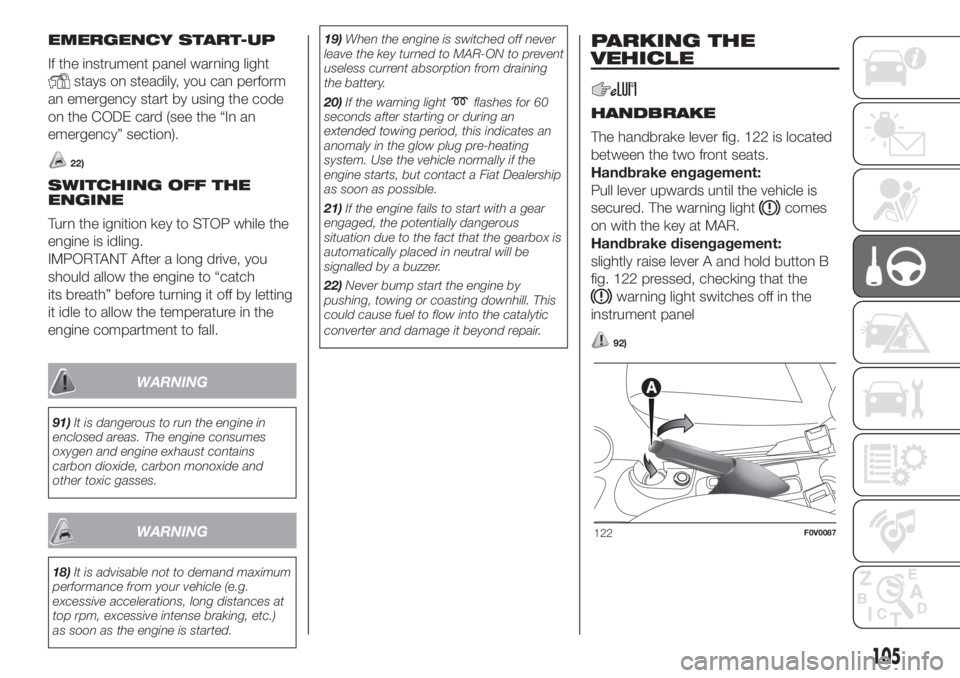
EMERGENCY START-UP
If the instrument panel warning light
stays on steadily, you can perform
an emergency start by using the code
on the CODE card (see the “In an
emergency” section).
22)
SWITCHING OFF THE
ENGINE
Turn the ignition key to STOP while the
engine is idling.
IMPORTANT After a long drive, you
should allow the engine to “catch
its breath” before turning it off by letting
it idle to allow the temperature in the
engine compartment to fall.
WARNING
91)It is dangerous to run the engine in
enclosed areas. The engine consumes
oxygen and engine exhaust contains
carbon dioxide, carbon monoxide and
other toxic gasses.
WARNING
18)It is advisable not to demand maximum
performance from your vehicle (e.g.
excessive accelerations, long distances at
top rpm, excessive intense braking, etc.)
as soon as the engine is started.19)When the engine is switched off never
leave the key turned to MAR-ON to prevent
useless current absorption from draining
the battery.
20)If the warning light
flashes for 60
seconds after starting or during an
extended towing period, this indicates an
anomaly in the glow plug preheating
system. Use the vehicle normally if the
engine starts, but contact a Fiat Dealership
as soon as possible.
21)If the engine fails to start with a gear
engaged, the potentially dangerous
situation due to the fact that the gearbox is
automatically placed in neutral will be
signalled by a buzzer.
22)Never bump start the engine by
pushing, towing or coasting downhill. This
could cause fuel to flow into the catalytic
converter and damage it beyond repair.
PARKING THE
VEHICLE
HANDBRAKE
The handbrake lever fig. 122 is located
between the two front seats.
Handbrake engagement:
Pull lever upwards until the vehicle is
secured. The warning light
comes
on with the key at MAR.
Handbrake disengagement:
slightly raise lever A and hold button B
fig. 122 pressed, checking that the
warning light switches off in the
instrument panel
92)
122F0V0087
105
Page 108 of 272
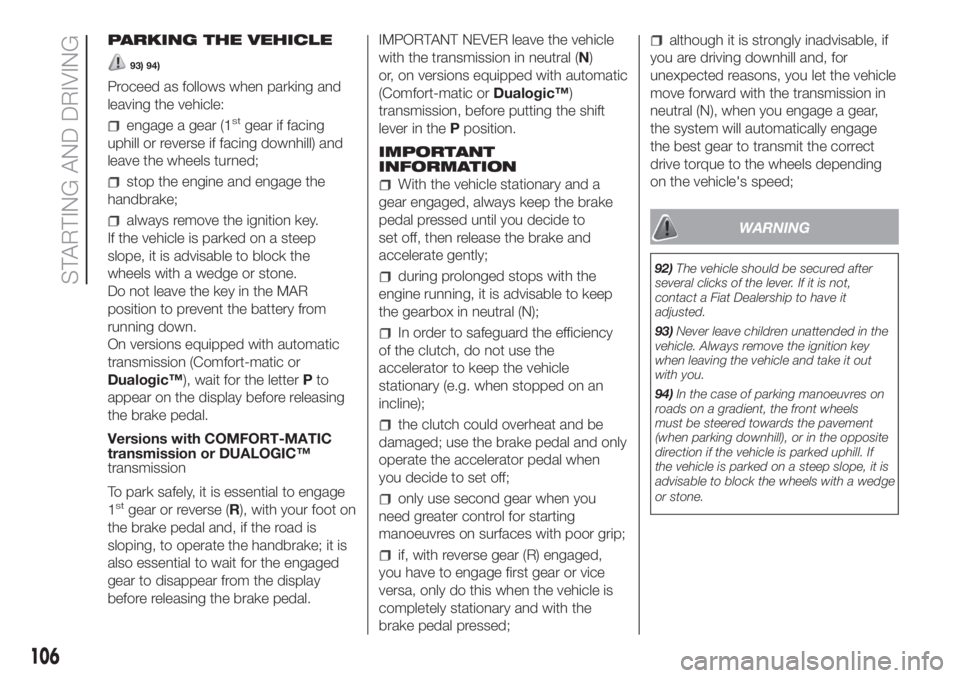
PARKING THE VEHICLE
93) 94)
Proceed as follows when parking and
leaving the vehicle:
engage a gear (1stgear if facing
uphill or reverse if facing downhill) and
leave the wheels turned;
stop the engine and engage the
handbrake;
always remove the ignition key.
If the vehicle is parked on a steep
slope, it is advisable to block the
wheels with a wedge or stone.
Do not leave the key in the MAR
position to prevent the battery from
running down.
On versions equipped with automatic
transmission (Comfort-matic or
Dualogic™), wait for the letterPto
appear on the display before releasing
the brake pedal.
Versions with COMFORT-MATIC
transmission or DUALOGIC™
transmission
To park safely, it is essential to engage
1
stgear or reverse (R), with your foot on
the brake pedal and, if the road is
sloping, to operate the handbrake; it is
also essential to wait for the engaged
gear to disappear from the display
before releasing the brake pedal.IMPORTANT NEVER leave the vehicle
with the transmission in neutral (N)
or, on versions equipped with automatic
(Comfort-matic orDualogic™)
transmission, before putting the shift
lever in thePposition.
IMPORTANT
INFORMATION
With the vehicle stationary and a
gear engaged, always keep the brake
pedal pressed until you decide to
set off, then release the brake and
accelerate gently;
during prolonged stops with the
engine running, it is advisable to keep
the gearbox in neutral (N);
In order to safeguard the efficiency
of the clutch, do not use the
accelerator to keep the vehicle
stationary (e.g. when stopped on an
incline);
the clutch could overheat and be
damaged; use the brake pedal and only
operate the accelerator pedal when
you decide to set off;
only use second gear when you
need greater control for starting
manoeuvres on surfaces with poor grip;
if, with reverse gear (R) engaged,
you have to engage first gear or vice
versa, only do this when the vehicle is
completely stationary and with the
brake pedal pressed;
although it is strongly inadvisable, if
you are driving downhill and, for
unexpected reasons, you let the vehicle
move forward with the transmission in
neutral (N), when you engage a gear,
the system will automatically engage
the best gear to transmit the correct
drive torque to the wheels depending
on the vehicle's speed;
WARNING
92)The vehicle should be secured after
several clicks of the lever. If it is not,
contact a Fiat Dealership to have it
adjusted.
93)Never leave children unattended in the
vehicle. Always remove the ignition key
when leaving the vehicle and take it out
with you.
94)In the case of parking manoeuvres on
roads on a gradient, the front wheels
must be steered towards the pavement
(when parking downhill), or in the opposite
direction if the vehicle is parked uphill. If
the vehicle is parked on a steep slope, it is
advisable to block the wheels with a wedge
or stone.
106
STARTING AND DRIVING
Page 111 of 272
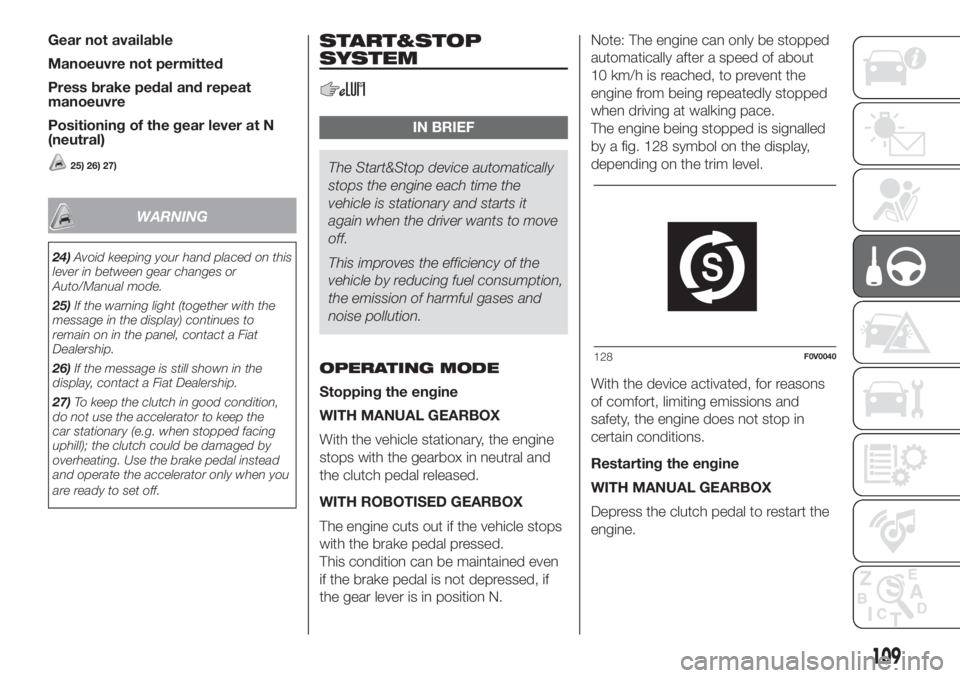
Gear not available
Manoeuvre not permitted
Press brake pedal and repeat
manoeuvre
Positioning of the gear lever at N
(neutral)
25) 26) 27)
WARNING
24)Avoid keeping your hand placed on this
lever in between gear changes or
Auto/Manual mode.
25)If the warning light (together with the
message in the display) continues to
remain on in the panel, contact a Fiat
Dealership.
26)If the message is still shown in the
display, contact a Fiat Dealership.
27)To keep the clutch in good condition,
do not use the accelerator to keep the
car stationary (e.g. when stopped facing
uphill); the clutch could be damaged by
overheating. Use the brake pedal instead
and operate the accelerator only when you
are ready to set off.
START&STOP
SYSTEM
IN BRIEF
The Start&Stop device automatically
stops the engine each time the
vehicle is stationary and starts it
again when the driver wants to move
off.
This improves the efficiency of the
vehicle by reducing fuel consumption,
the emission of harmful gases and
noise pollution.
OPERATING MODE
Stopping the engine
WITH MANUAL GEARBOX
With the vehicle stationary, the engine
stops with the gearbox in neutral and
the clutch pedal released.
WITH ROBOTISED GEARBOX
The engine cuts out if the vehicle stops
with the brake pedal pressed.
This condition can be maintained even
if the brake pedal is not depressed, if
the gear lever is in position N.Note: The engine can only be stopped
automatically after a speed of about
10 km/h is reached, to prevent the
engine from being repeatedly stopped
when driving at walking pace.
The engine being stopped is signalled
by a fig. 128 symbol on the display,
depending on the trim level.
With the device activated, for reasons
of comfort, limiting emissions and
safety, the engine does not stop in
certain conditions.
Restarting the engine
WITH MANUAL GEARBOX
Depress the clutch pedal to restart the
engine.
128F0V0040
109
Page 112 of 272
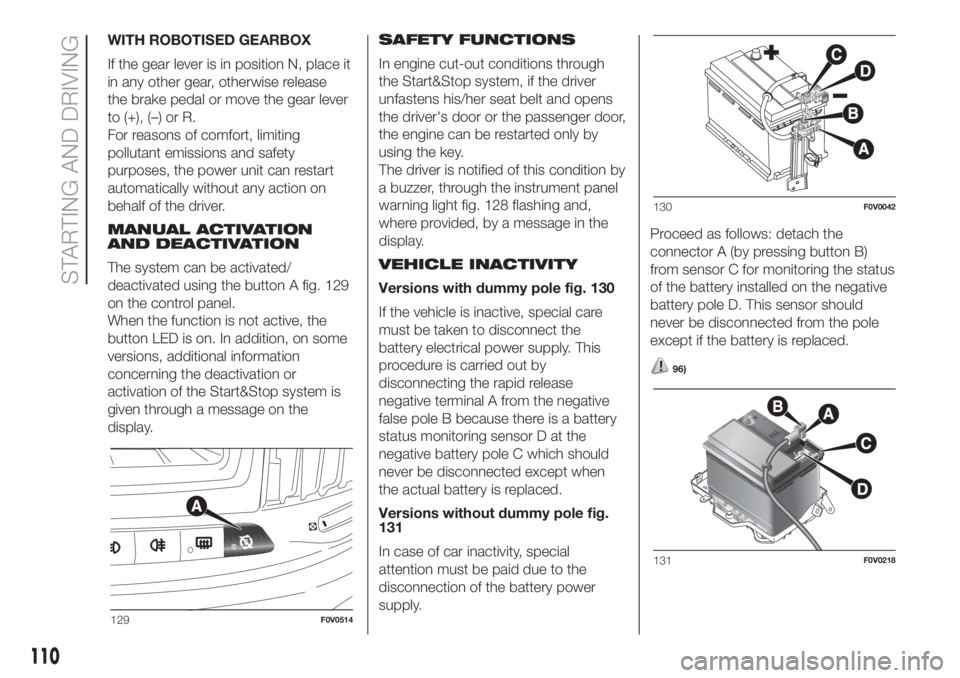
WITH ROBOTISED GEARBOX
If the gear lever is in position N, place it
in any other gear, otherwise release
the brake pedal or move the gear lever
to (+), (–) or R.
For reasons of comfort, limiting
pollutant emissions and safety
purposes, the power unit can restart
automatically without any action on
behalf of the driver.
MANUAL ACTIVATION
AND DEACTIVATION
The system can be activated/
deactivated using the button A fig. 129
on the control panel.
When the function is not active, the
button LED is on. In addition, on some
versions, additional information
concerning the deactivation or
activation of the Start&Stop system is
given through a message on the
display.SAFETY FUNCTIONS
In engine cut-out conditions through
the Start&Stop system, if the driver
unfastens his/her seat belt and opens
the driver's door or the passenger door,
the engine can be restarted only by
using the key.
The driver is notified of this condition by
a buzzer, through the instrument panel
warning light fig. 128 flashing and,
where provided, by a message in the
display.
VEHICLE INACTIVITY
Versions with dummy pole fig. 130
If the vehicle is inactive, special care
must be taken to disconnect the
battery electrical power supply. This
procedure is carried out by
disconnecting the rapid release
negative terminal A from the negative
false pole B because there is a battery
status monitoring sensor D at the
negative battery pole C which should
never be disconnected except when
the actual battery is replaced.
Versions without dummy pole fig.
131
In case of car inactivity, special
attention must be paid due to the
disconnection of the battery power
supply.Proceed as follows: detach the
connector A (by pressing button B)
from sensor C for monitoring the status
of the battery installed on the negative
battery pole D. This sensor should
never be disconnected from the pole
except if the battery is replaced.
96)
129F0V0514
130F0V0042
131F0V0218
110
STARTING AND DRIVING